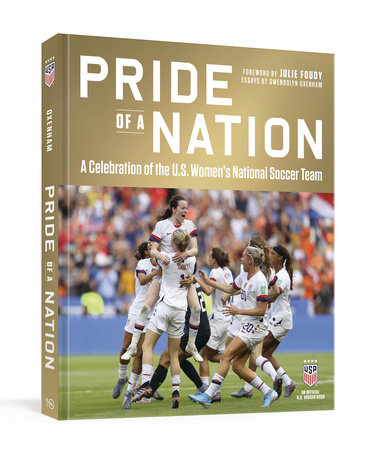Excerpt
Pride of a Nation
The PioneersAt the opening ceremony of the 1985 National Sports Festival in Baton Rouge, Louisiana, diver Greg Louganis carries the torch as fireworks explode in the sweltering night sky. The 55,000 fans filling LSU’s Tiger Stadium are there to watch the top amateur athletes in the U.S. compete against one another—and among them are seventy of the country’s best women soccer players. There’s a feeling in the air: Something is brewing.
At the festival’s end, officials announce that a national team is forming. They call out seventeen names. Every player sitting in the grass hopes to hear her name.
There is no women’s soccer in the Olympics yet. There is no women’s World Cup. But that stops no one from dreaming.
These pioneers—most of whom you’ve never heard of—start everything, playing in an era when you still had to hand back your USA gear after each trip.
Their stories hinge on grit: They follow this game anywhere. Take Emily Pickering, a self-described “poor kid” from Long Island. She would lose her brother to a drunk driver when she was six; in high school, her best friend died in a car accident while sitting next to her. The game was what Pickering had. Her high school coach drove her nine hours to Chapel Hill because UNC was one of the few schools with scholarships. That audition changed her life. “She was a frigging ass kicker,” says UNC coach Anson Dorrance. “She was the alpha.”
Kim Crabbe, the first Black player ever called up to the National Team, describes her single mother as her “forever hero.” While her mom worked three jobs to support the family, Kim’s favorite youth coach, Mr. Fox, gave her rides to games in his red VW bus. Her aunt, dubbed “Lil’ Feisty,” also played—well into her sixties—and came to her niece’s games. “If someone made a choice comment—especially about a teammate of color—Auntie was the one who set them straight,” says Crabbe.
Lisa Gmitter, a Jersey girl, won the first collegiate Player of the Year award in 1985 after her George Mason team beat UNC to win the NCAA championship. She has a dozen notebooks full of memories: borrowing a bicycle from a stranger because she was late to a banquet in China; cutting her teammates’ hair as the unofficial team barber; scoring a goal against Sweden; ordering pizza with her fifteen-year-old roommate, Mia Hamm.
Lori Henry was a three-year captain of the USWNT who shouted curse words on the field so often that the coaches implemented a no-swearing rule. Joan Dunlap scored the 1981 National Championship-winning penalty kick for her amateur team, the Seattle Sharks, when she was five months pregnant; two years later, she got a full ride to UNC and brought her toddler with her. Margaret “Tucka” Healy entered UC Berkeley in 1981; the school didn’t offer scholarships, but when she graduated, her coach gave her five hundred dollars for a plane ticket to Germany so she could continue playing. Pickering quit her payroll job to go play for Juventus in Italy. Forward Shannon McMurty went to play in Australia. But many of the older players eventually asked themselves:
How long before I start my life? Without a way of making a living from soccer in the United States, the women began to move on. Healy remembers standing on the field during a corner kick in the middle of a club game, looking at her teammates in uniform, and thinking,
What am I still doing out here? After that she only played for fun. “It was not easy to quit,” says Healy. She became employee number 81 at a little start-up company in Mountain View called Google. “My experience with the National Team taught me to be early and first—and that I loved being at the beginning of things,” says Healy. Cindy Gordon, a scrappy forward, would become a scientist at a biomedical genetics lab. Goalkeeper Kim Wyant went on to become the head coach of NYU’s men’s soccer team—one of only two women coaching men in the NCAA.
Many of these women have stayed in the game—Crabbe now runs a free youth city league for at-risk kids in Wilmington and was named U.S. Soccer Coaches’ 2021 Youth Coach of the Year. After the local news ran a story about Crabbe, her players stared up at her, a touch aggrieved. “Why,” they asked, “didn’t you tell us who you are?” Now they know: Their coach is one of the originals—a trailblazer for the millions of dreamers to come.




